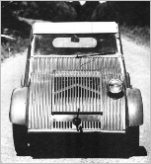


†
In 1998 the CitroŽn 2CV officially celebrates it's fifthieth birthday. In 1948 the first 2CV was manufactured. In those days, CitroŽn had a swan in it's logo, which made a journalist remark that Citroen's swan had given birth to an ugly duckling. The car never got rid of this name.
The first plans for making the 2CV go longer back. Already in 1935 Andrť CitroŽn figured that the French peasants needed a little car, as a replacement for horse and carriage. The luxurous cars driving around in those days are not at all fitted for this purpose. CitroŽn himself will not live to see the introduction of the car. He dies in 1935. By that time the factory has been taken over by Michelin. They think the TPV (toute petite voiture) has a future and continue the development of the car. Manager of the project is Pierre Boulanger. His assignment: "Build a economical car for 'the French peasant', possibly a co-driver and some goods, in which he can drive from and to the field and market, but also to church. Therefore he must be able to wear a hat."
The constructor of the car is going to be engineer Andrť LefŤbvre. To meet the demand of economity, he uses aluminium and magnesium. This doesn't result in instant success. One of the prototypes complety burns due to a shortcircuit. The engine, which isn't made of aluminium, remains intact. Besides that, LefŤbvre isn't satisfied with the first model and starts all over again. After four years of experimenting, still no satisfying model has been designed. Then war breaks out. Boulanger is afraid the Germans might want to use the TPV as a war vehicle and orders all prototypes to be destroyed. The introduction of the 2CV seems farther away than ever...
But Boulanger does not quit. During the war he can't stop thinking about the TPV. He drops the idea of using aluminium and magnesium. In this period he meets two technicians that left another factury after a dispute. They are motor constructer Walter Becchia and carburettor specialist Lucien Girard. Becchia designs the air-cooled engine (up to that period the TPV had a water-cooled motor). Becchia's design seems to be working OK. Within a month a prototype runs for five hundred hours, without any problems.
After the war is finished, the team enthusiastically continues to develop the 2cv. They are now using 'regular' materials, the roadability is improved, heating is implemented and from now on the car has two headlights. In the meantime different designers are working on the looks of the 2CV. In the end the cars is shaped according to the ideas of Steck en Caneua. Just before the 1948 Salon de l'Automobile in Paris an electric ignition is implemented. The crank doesn't function that well after all.
During the exhibition the 2CV is ridiculed. Everyone is convinced CitroŽn has made a huge mistake. But the 2CV turns out to be an enormous success. During the years more models are launched and the group of fans is rapidly increasing. Despite that, during the eighties CitroŽn desides to quit producing the 2CV. In 1990 the last one leaves the factury.